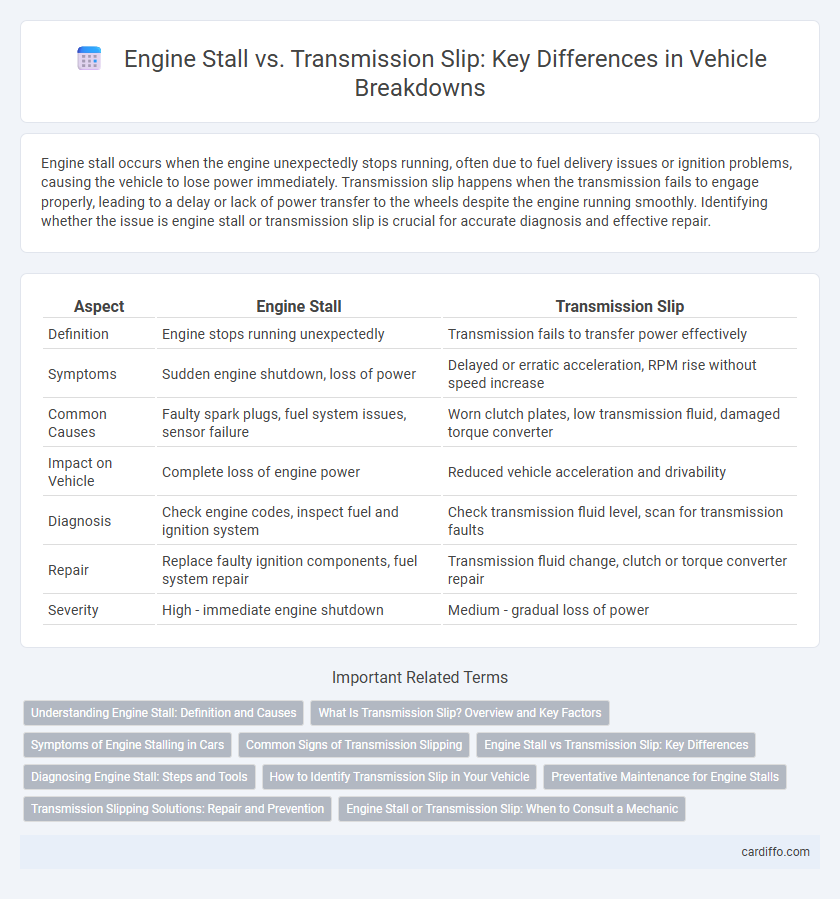Engine stall occurs when the engine unexpectedly stops running, often due to fuel delivery issues or ignition problems, causing the vehicle to lose power immediately. Transmission slip happens when the transmission fails to engage properly, leading to a delay or lack of power transfer to the wheels despite the engine running smoothly. Identifying whether the issue is engine stall or transmission slip is crucial for accurate diagnosis and effective repair.
Table of Comparison
| Aspect | Engine Stall | Transmission Slip |
|---|---|---|
| Definition | Engine stops running unexpectedly | Transmission fails to transfer power effectively |
| Symptoms | Sudden engine shutdown, loss of power | Delayed or erratic acceleration, RPM rise without speed increase |
| Common Causes | Faulty spark plugs, fuel system issues, sensor failure | Worn clutch plates, low transmission fluid, damaged torque converter |
| Impact on Vehicle | Complete loss of engine power | Reduced vehicle acceleration and drivability |
| Diagnosis | Check engine codes, inspect fuel and ignition system | Check transmission fluid level, scan for transmission faults |
| Repair | Replace faulty ignition components, fuel system repair | Transmission fluid change, clutch or torque converter repair |
| Severity | High - immediate engine shutdown | Medium - gradual loss of power |
Understanding Engine Stall: Definition and Causes
Engine stall occurs when the engine suddenly stops running while the vehicle is in operation, often caused by fuel delivery issues, ignition system failures, or air intake obstructions. This abrupt loss of engine power distinguishes it from transmission slip, which involves the gearbox failing to effectively transfer power to the wheels. Recognizing symptoms like engine sputtering, loss of acceleration, and dashboard warning lights can help diagnose an imminent stall.
What Is Transmission Slip? Overview and Key Factors
Transmission slip occurs when the engine's power is not effectively transferred to the wheels, causing a delay or loss of acceleration. Key factors contributing to transmission slip include worn clutches, low transmission fluid, or a failing torque converter. Identifying transmission slip is crucial, as it differs from engine stall, which involves the engine shutting off rather than loss of power delivery to the wheels.
Symptoms of Engine Stalling in Cars
Engine stalling in cars often manifests through sudden loss of power and unexpected shutdown while idling or driving, causing the vehicle to jerk or hesitate. Common symptoms include rough idling, engine sputtering, and frequent stalling at stoplights or during acceleration. Unlike transmission slip, which primarily affects gear shifting, engine stall symptoms involve the engine ceasing to run, leading to potential safety hazards on the road.
Common Signs of Transmission Slipping
Transmission slipping often manifests through delayed or erratic gear shifts, unusual whining or grinding noises, and a noticeable loss of acceleration despite engine revving. These symptoms differ from engine stall, which typically involves abrupt engine shutdown without power transfer issues. Recognizing these common signs helps distinguish transmission problems, enabling timely repair and avoiding further drivetrain damage.
Engine Stall vs Transmission Slip: Key Differences
Engine stall occurs when the engine unexpectedly shuts off, causing a complete loss of power, often due to fuel delivery issues or ignition failure. Transmission slip, on the other hand, involves the transmission failing to properly engage gears, resulting in inconsistent acceleration and a noticeable delay between engine speed and vehicle movement. Understanding these key differences helps diagnose whether the problem lies within the engine's combustion process or the transmission's mechanical operation.
Diagnosing Engine Stall: Steps and Tools
Diagnosing engine stall involves inspecting the fuel system, ignition components, and air intake for blockages or faults using diagnostic scanners like OBD-II readers. Checking engine sensors such as the crankshaft position sensor and mass airflow sensor ensures accurate engine timing and fuel mixture, crucial for preventing stalls. Mechanics also use multimeters and vacuum gauges to detect electrical inconsistencies and vacuum leaks that may cause engine disruption.
How to Identify Transmission Slip in Your Vehicle
Transmission slip can be identified by a noticeable delay or hesitation when shifting gears, often accompanied by an unexpected increase in engine RPM without a corresponding increase in vehicle speed. Another key indicator is a burning smell or unusual noises coming from the transmission area during acceleration. Monitoring fluid levels and condition, particularly the presence of burnt or discolored transmission fluid, also helps diagnose transmission slip early.
Preventative Maintenance for Engine Stalls
Engine stalls often result from fuel delivery or ignition system issues, while transmission slips relate to gear engagement problems. Preventative maintenance for engine stalls includes regularly checking fuel filters, spark plugs, and ignition coils to ensure optimal performance. Timely oil changes and routine diagnostics can further reduce the risk of unexpected engine shutdowns and enhance overall vehicle reliability.
Transmission Slipping Solutions: Repair and Prevention
Transmission slipping can cause dangerous breakdowns requiring immediate attention to prevent costly repairs. Effective solutions include replacing worn clutch plates, repairing fluid leaks, and performing regular transmission fluid changes using manufacturer-recommended fluids. Preventive maintenance such as monitoring transmission temperature, avoiding abrupt gear shifts, and scheduling routine inspections significantly reduces the risk of transmission slip and extends vehicle longevity.
Engine Stall or Transmission Slip: When to Consult a Mechanic
Engine stall occurs when the engine unexpectedly stops running, often caused by fuel delivery issues, ignition problems, or sensor malfunctions, requiring prompt diagnostic services. Transmission slip, identified by delayed or erratic gear shifts and unusual noises, signals possible clutch wear or fluid problems that demand immediate mechanical inspection. Consulting a mechanic is crucial when experiencing repeated engine stalls or transmission slipping to prevent costly repairs and ensure vehicle safety.
Engine stall vs transmission slip Infographic

 cardiffo.com
cardiffo.com